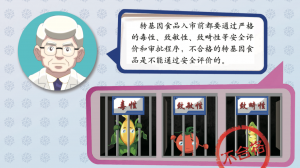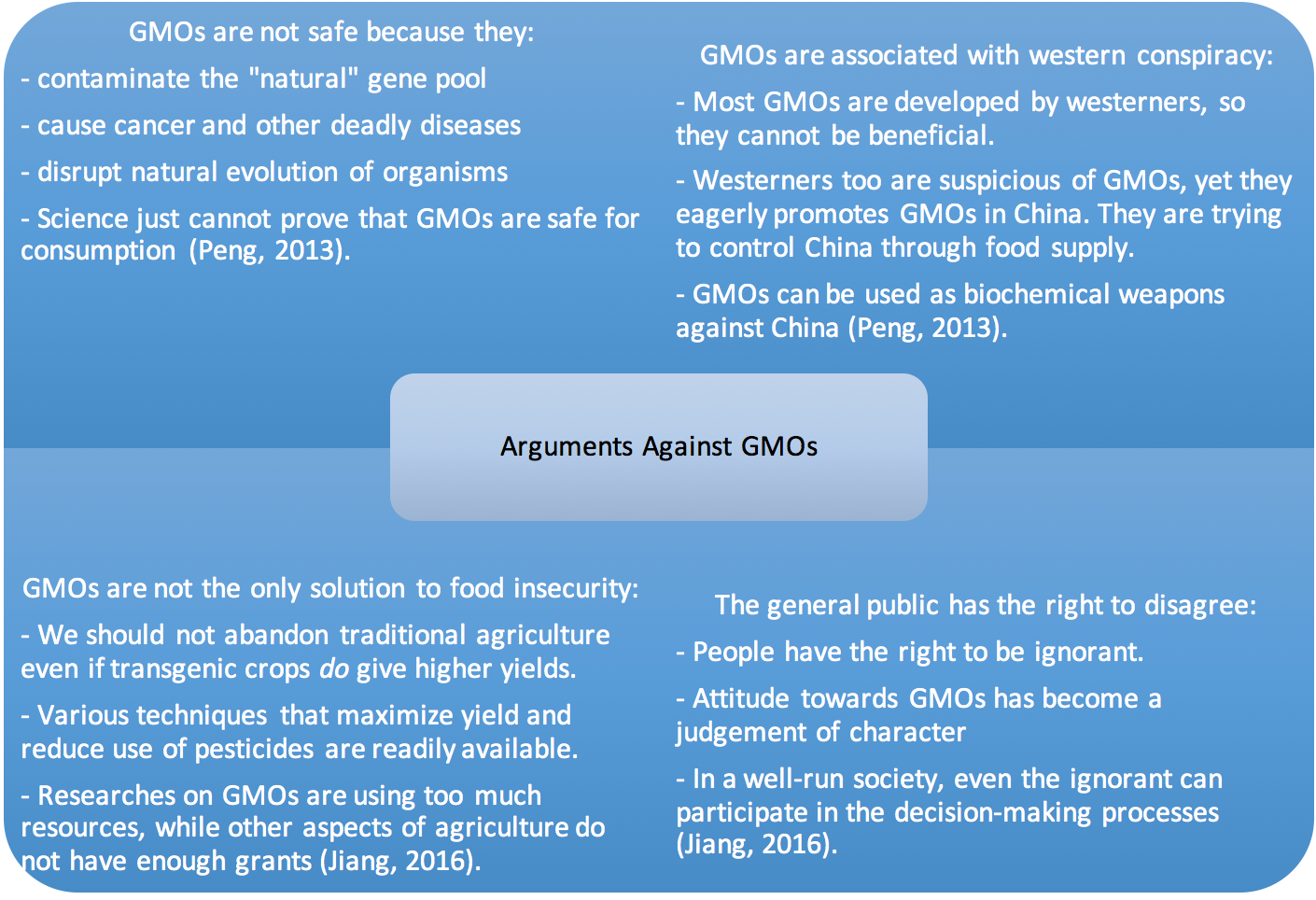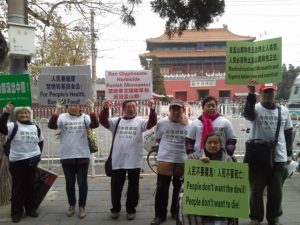Governement Approval
The Chinese government supports genetically modified organisms (GMOs) which have been rigorously tested by the Ministry of Agriculture (MOA, 中国农业部). All strains of GMOs are subject to rigorous testing prior to approval. In fact, the approval of one strain of Bt rice developed by Huazhong Agricultural University (华中科技大学) in 2009 took as long as 11 years (Ministry of Agriculture [MOA], 2015, p.3).

Fig. 1: The Simplified Approval Process of GMOs under MOA (MOA, 2010, pp.2-18)
The most important processes are Environmental Release, Mass Cultivation Study, Laborotory Analysis. Environmental Release tests the effect of GMOs on other organisms in the environment, and Mass Cultivation Study evaluates the viability and effectiveness of commercial cultivation of that strain of GMO (MOA, 2010, pp. 2-18).
Overall, MOA is rather supportive of approved GMOs. On the web page titled Authority Focus on GMOs (转基因权威关注), which has been established by MOA, numerous articles in conversational language and illustrative brochures have been published to illustrate the safety of approved GMOs. Most arguments for GMOs are based on the approval process illustrated in Fig. 1.

Fig 2: Sample brochure which explains that unsafe GMOs are never approved (Ministry of Agriculture, 2015, p.3)
Translation: Before GMOs are allowed in the market, they are subject to rigorous safety evaluation, such as toxicity, allergenicity, and teratogenicity testing, and approval processes. Unqualified GMOs are never going to pass our safety evaluation. The three plants in jail represents toxicity, allergenicity, and teratogenicity. The red stamp reads “unqualified.”
Grassroots Activism
Grassroots activism against GMOs prevailed despite government efforts. Like MOA, which has a website dedicated to persuading people that approved GMOs are safe to consume, anti-GMO activists too have a website, titled Utopia, with numerous articles written in colloquial language dedicated to persuading people that GMOs are detrimental.

Fig. 3: A Summary of Arguments made Against GMOs
The figure above shows main arguments made against GMO. Most activities organized by anti-GMO organizations aim at convincing people using arguments shown above.
Protests and Publicity
Anti-GMO activism was not limited to articles published on websites. The most common form of anti-GMO activism, aside from websites, is protests. Usually, a protest would involve standing with poster and handing out anti-GMO brochures to the people passing by.

Fig. 4: An Anti-GMO Protest on Nov. 6th, 2016.
As shown by Fig. 4, protesters would hold up posters so that people passing by could easily read the slogans. Protesters would also hand out brochures to nearby people and explain the detrimental effects of GMOs as well.
The account of this protest, written in provocative language, was also made available:
…the spirit of Sun is an inspiration to the revolution against evil foreign capitalism…volunteers walked and stopped occasionally to explained the detrimental effects of GMOs to people passing by! People praised the volunteers and commented that anti-GMO activism should be as ambitious as possible … an old man even ran after us for fliers, for he was influenced by both pro-GMO and anti-GMO arguments and desperately wanted to know the truth (Yanshanchunyu, 2016)…
Indeed, such posts on anti-GMO protests often invoke:
- The conviction that GMOs are not safe.
- The conviction that GMOs are associated with foreign conspiracy.
However, such convictions remain mere rumors. Indeed, the rigorous approval process was made readily available online for the general public (See the section titled “Government Approval of GMOs”). For those who cannot understand scholarly articles, the Ministry of Agriculture have also postes articles written in colloquial language that respond to arguments against GMOs.

Fig. 5 A Summary of Response to anti-GMO arguments
Sources
- Ministry of Agriculture. (2010). 转基因植物评估指南 [Guidelines for Safety Assessments of Transgenic Plants]. Retrieved from Ministry of Agruiculture Website: http://www.moa.gov.cn/ztzl/zjyqwgz/sbzn/201202/t20120203_2474485.htm
2. – (2009). 2009 年第二批农业转基因生物安全证书批准清单 [List of Approved Transgenic Organisms in 2009]. Retrieved from Ministry of Agriculture Website: http://www.moa.gov.cn/ztzl/zjyqwgz/spxx/201202/t20120203_2474158.htm
3. – (2015). 转基因食品与非转基因食品同样安全 [Transgenic Food is As Safe as Non-transgenic Food] [Brochure]. Retrieved from Ministry of Agriculture Website: http://www.moa.gov.cn/ztzl/zjyqwgz/kpxc/201504/t20150427_4564391.htm
4. Fig. 4 Yangfangzhou99 (2016 Nov) Image of anti-GMO Protest on Nov 6th 2016, [Digital Image]. Retrieved Nov 07, 2016 from http://blog.sina.com.cn/s/blog_684232160102wi17.html
5. Yanshanchunyu. (2016, Nov 07). 北京志愿者2016年11月6日景山周边反转基因宣传纪实 [A Record of Anti-GMO Protest by Beijing Volunteers on Nov 06, 2016 around Jing Shan]. Retrieved from http://www.wyzxwk.com/Article/shidai/2016/11/373196.html
6. He, C. (2013, Aug 28). 魔鬼还是天使?林敏回应“八问主粮转基因化” [Devil or Angel? Lin Min’s Reply to Eight Questions for Transgenic Staple Food]. Chinese Science Daily. Retrieved from: http://news.sciencenet.cn/sbhtmlnews/2013/8/277187.shtm
7. Huang, D. (2013, Aug 26). 黄大昉:“反转基因思潮”辨析 [A Detailed Analysis of the Motivation of anti-GMO Sentiments] Retrieved from http://news.sciencenet.cn/htmlnews/2013/8/281691.shtm
